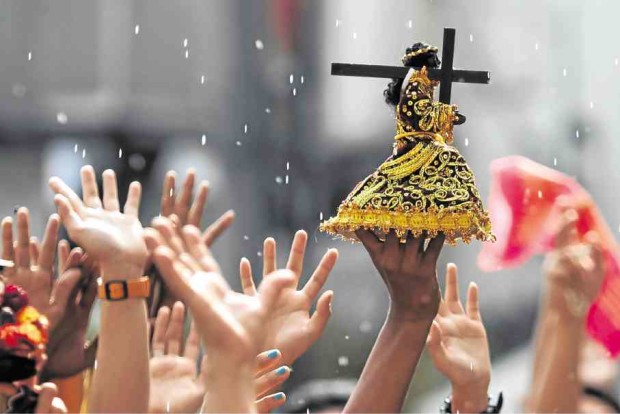Ex-addicts to join ‘traslacion’

BLESSING RITES A priest sprinkles holy water over replicas of the Black Nazarene image. Millions are expected to show up in today’s “traslacion” when the image is brought from Rizal Park to Quiapo Church in Manila. —LEO M. SABANGAN
Former drug users who surrendered under the Philippine National Police’s “Oplan Tokhang” will join the Black Nazarene procession in Manila today in hopes of ushering changes in public perception not only of addicts but also of how policemen handle surrenderers.
“We want to show drug users that they can change if they want to change,” the Ermita police station chief, Supt. Romeo Desiderio, told the Inquirer on Sunday.
“We also want to change the public perception that you will die when you surrender to the government’s Oplan Tokhang. That’s not true and this is our proof,” Desiderio said.
About 100 surrenderers, who have been under the Ermita police station’s care, will don white shirts and join millions of mostly barefoot devotees tread the procession route.
Among the words printed on the shirts are: “Proud to be drug free” and “ISupportProjectDoubleBarrel.”
Article continues after this advertisement‘There is hope’
Desiderio said Manila policemen thought of this project in order to “uplift” the former drug users and at the same time show them “there is hope.”
Article continues after this advertisementOplan Tokhang, or knock and plead, is the PNP campaign that compels suspected drug users and pushers to “surrender” so they can have a chance to lead straight lives.
However, critics and relatives of victims noted that after surrendering, many of these drug suspects would later die—either at the hands of the police or unidentified gunmen.
“We want to help these people change. We treat them as humans. It does not mean you’ll die once you become a surrenderer. That’s just an exaggeration,” he said.
No selfie at ‘pahalik’
On the eve of the “traslacion,” or procession, thousands of devotees flocked to Quirino Grandstand for the traditional “pahalik” (kissing and touching the image).
The queue moved slowly, prompting authorities to prohibit devotees from taking selfies with the image of the Black Nazarene.
“They pray, touch the Nazarene, then take selfies. This routine takes about 15 seconds. So, organizers prohibit people from taking selfies because it causes delay,” Desiderio said.
People began trooping to the site on Saturday night. As of 3 p.m. on Sunday, the crowd was estimated at 27,000.
“That’s a generous estimate,” said Desiderio, who noted that there were fewer attendees this year than in 2016.
One attendee, Ernesto Ferrera, 55, joined the traditional pahalik not to ask for grace but to thank the purported miraculous image for the blessings he and his family have received for the past 20 years.
The father of four was misty-eyed as he recalled how, two decades ago, he would join the tradition to ask God for help.
Ferrera was penniless and had nowhere to run to when he discovered the basilica in Quiapo.
“I was broke and lived far from my parents. At that time, my eldest had just been born and I just lost my job. My wife and I didn’t know where to get money to raise her. That’s when I turned to God through the Nazarene. That’s how I discovered this faith,” Ferrera said.
Wishes granted
His wishes, he said, were granted. Twenty years later, his children were able to finish school. He was able to put up his own business and to buy his own house. “I could not ask for more,” he said.
Since then, Ferrera never stopped his adoration of the Black Nazarene. And although he has never joined the Jan. 9 procession, he and his family would yearly endure long lines just to kiss and touch the image of the Black Nazarene for the pahalik.
“It’s faith. No matter what people tell me, I will never stop adoring the Nazarene,” he said.
“But I stopped asking God for favors. Now, I am here to give Him thanks because there’s nothing to ask for anymore. He already gave me everything and I am grateful,” he said.
The pahalik started at 7:30 a.m. Last year, it started a day earlier on Jan. 7.
Most of those who came were female adults. Desiderio also noted that the number of teenagers were fewer this year.
He said the number was still expected to climb because the crowd was expected to pour in at 6 p.m.